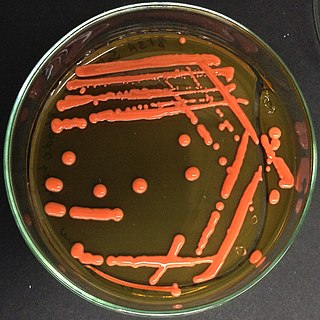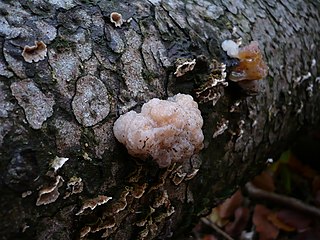
Rhodotorula is a genus of fungi in the class Microbotryomycetes. Most species are known in their yeast states which produce orange to red colonies when grown on Sabouraud's dextrose agar (SDA). The colour is the result of pigments that the yeast creates to block out certain wavelengths of light (620–750 nm) that would otherwise be damaging to the cell. Hyphal states, formerly placed in the genus Rhodosporidium, give rise to teliospores from which laterally septate basidia emerge, producing sessile basidiospores. Species occur worldwide and can be isolated from air, water, soil, and other substrates.

The Ustilaginomycotina is a subdivision within the division Basidiomycota of the kingdom Fungi. It consists of the classes Ustilaginomycetes and Exobasidiomycetes, and in 2014 the subdivision was reclassified and the two additional classes Malasseziomycetes and Monilielliomycetes added. The name was first published by Doweld in 2001; Bauer and colleagues later published it in 2006 as an isonym. Ustilagomycotina and Agaricomycotina are considered to be sister groups, and they are in turn sister groups to the subdivision Pucciniomycotina.

Pucciniomycotina is a subdivision of fungus within the division Basidiomycota. The subdivision contains 10 classes, 21 orders, and 38 families. Over 8400 species of Pucciniomycotina have been described - more than 8% of all described fungi. The subdivision is considered a sister group to Ustilaginomycotina and Agaricomycotina, which may share the basal lineage of Basidiomycota, although this is uncertain due to low support for placement between the three groups. The group was known as Urediniomycetes until 2006, when it was elevated from a class to a subdivision and named after the largest order in the group, Pucciniales.
The Agaricostilbomycetes are a class of fungi in the subdivision Pucciniomycotina of the Basidiomycota. The class consists of a single order, six families, and 15 genera. Most species are known only from their yeast states. Where known, basidiocarps (fruitbodies) are typically small and stilboid (pin-shaped).

The Microbotryomycetes are class of fungi in the Pucciniomycotina subdivision of the Basidiomycota. Until recently, the class contained four orders: the Heterogastridiales, the Leucosporidiales, the Microbotryales, and the Sporidiobolales, which contained a total of 4 families, 25 genera, and 208 species. The order Kriegeriales, containing two families, Kriegeriaceae and Camptobasidiaceae, was defined in 2012.
Bulleribasidium is a genus of fungi in the family Bulleribasidiaceae. The genus currently contains some eleven species. The type species is a parasite of other fungi, its teleomorph having septate basidia and haustorial cells on its hyphae that connect to the host hyphae. Most species are, however, only known from their yeast states.
The Heterogastridiales are an order of fungi in the Microbotryomycetes class of the Basidiomycota. The order contains a single family, the Heterogastridiaceae, which in turn contains five genera. Both the family and the order were circumscribed in 1990.
The Leucosporidiales are an order of fungi in the Microbotryomycetes class of the Basidiomycota. The order contains a single family, the Leucosporidiaceae, which in turn contains three genera and eight species. The order was circumscribed in 2003; the family was first described in 1981, but the naming was invalid, and subsequently redescribed in 2001.
Colacogloea is a genus of fungi belonging to the class Microbotryomycetes. Most species in the genus are known only from their yeast states. Where known, basidiocarps have auricularioid basidia and occur as parasites on or in the fruit bodies of other fungi.

Phaeotremella is a genus of fungi in the family Phaeotremellaceae. All Phaeotremella species are parasites of other fungi and produce anamorphic yeast states. Basidiocarps, when produced, are gelatinous and are colloquially classed among the "jelly fungi". Fifteen or so species of Phaeotremella are currently recognized worldwide.

Naematelia is a genus of fungi in the family Naemateliaceae. All Naematelia species are parasites of other fungi and produce anamorphic yeast states. Basidiocarps, when produced, are gelatinous and are colloquially classed among the "jelly fungi". Four species of Naematelia are currently recognized worldwide. One species, Naematelia aurantialba, is commercially cultivated for food.
Pseudotremella is a genus of fungi in the family Bulleraceae. All Pseudotremella species are parasites of other fungi and produce anamorphic yeast states. Basidiocarps, when produced, are gelatinous and are colloquially classed among the "jelly fungi". Four species of Pseudotremella are currently recognized worldwide. Two of these species are, as yet, only known from their yeast states.

The Platygloeales are an order of fungi in the class Pucciniomycetes. Species in the order have auricularioid basidia and are typically plant parasites on mosses, ferns, and angiosperms, though Platygloea species appear to be saprotrophic.
The Spiculogloeomycetes are a class of fungi in the subdivision Pucciniomycotina of the Basidiomycota. The class consists of a single order, the Spiculogloeales. Which contains one family, SpiculogloeaceaeDenchev, 2009, which holds 2 genera; Phyllozyma and Spiculogloea.

Mrakia is a genus of fungi in the order Cystofilobasidiales. The genus comprises yeasts, some of which have a hyphal state forming teliospores from which basidia arise. Mrakia species are typically psychrophilic, many originally isolated from glaciers and frigid environments, and are capable of low-temperature fermentation, making them of potential interest in brewing and bioremediation.
The Cystobasidiales are an order of fungi in the class Cystobasidiomycetes. The order currently consists of a single family (Cystobasidiaceae) and two genera as yet unassigned to a family.
Cystobasidium fimetarium is a species of fungus in the order Cystobasidiales. It is a fungal parasite forming small gelatinous basidiocarps on various ascomycetous fungi on dung. Microscopically, it has auricularioid basidia producing basidiospores that germinate by budding off yeast cells. The species is known from Europe and North America.
Occultifur is a genus of fungi in the family Cystobasidiaceae. Species are parasites of other fungi and, microscopically, have auricularioid basidia and basidiospores that germinate by yeast cells. Several species are currently only known from their yeast states. The genus is distributed worldwide.

The Kriegeriaceae are a family of fungi in the subdivision Pucciniomycotina. The family currently comprises four genera, one of which (Kriegeria) contains a plant pathogenic species with auricularioid basidia. The other genera contain species currently known only from their yeast states.
The Camptobasidiaceae are a family of fungi in the subdivision Pucciniomycotina. The family currently comprises two genera, one of which (Camptobasidium) contains an aquatic, hyphal species with auricularioid basidia. The other genus contains species currently known only from their yeast states.











